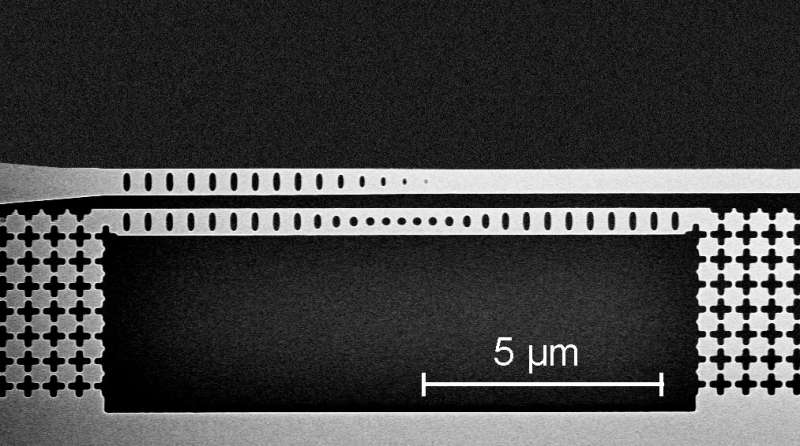June 15, 2020 feature
A quantum memory that operates at telecom wavelengths

To create large quantum networks, researchers will first need to develop efficient quantum repeaters. A key component of these repeaters are quantum memories, which are the quantum-mechanical equivalents of more conventional computer memories, such as random-access memories (RAM).
Ideally, a quantum memory should be able to retain information for substantial periods of time, store true quantum states, read out data efficiently and operate at low-loss telecommunication wavelengths. While research teams have made great progress in the development of quantum memories, no solution proposed so far has been able to meet all of these requirements simultaneously.
With this in mind, researchers at Delft University of Technology (TU Delft) set out to develop a new mechanical quantum memory with sufficiently long storage times, a high readout efficiency, and the ability to operate at telecom wavelengths. The memory they devised, presented in a paper published in Nature Physics, could ultimately enable the practical implementation of mechanical systems with quantum effects developed in their previous works.
"We've been working on showing quantum effects of mechanical systems for quite a few years now, and have been quite successful in realizing various quantum states, so we've really been pushing them toward a quantum information processing direction," Simon Gröblacher, professor at TU Delft, whose research group carried out the study, told Phys.org. "To use some of these devices for quantum information processing, however, one fist has to show that they can be used to build a quantum repeater and the main component of a quantum repeater is a quantum memory."
When they started working on their quantum memory, Gröblacher and his colleagues were aware that the mechanical resonators behind some of their devices could support very long lifetimes. They thus wanted to test them to see what storage times they could support, while also investigating their coherence (i.e., how quickly they would de-phase).
"We designed a system that has a few milliseconds lifetime, based on our previous work, then tested it and found that its storage time was indeed around two milliseconds.," Gröblacher said. "As a second step, we had to verify that quantum states and their phase information was preserved over this time. To do this, we created a superposition of the mechanical system and looked at how the phase in the superposition would evolve over time."
When the researchers first evaluated their quantum memory, they found that its superposition state decayed faster than the overall lifetime. This was far from a surprising result, as many previously developed systems were found to present the same decay pattern. Gröblacher and his colleagues set out to explore this finding further in order to better understand the mechanisms behind this short decoherence time.
"The general goal of our study was to show that mechanics can in fact be used as a quantum memory and we achieved this," Gröblacher said. "Remarkably, it is the first time that anyone has shown this."
The quantum memory devised by Gröblacher and his colleagues has several advantageous characteristics. One of the main ones is that it is fully engineerable, which means that the optical wavelengths at which it operates are selectable, as the system's optical and mechanical resonances are fully artificial. The researchers designed them using a computer and then fabricated the device accordingly.
"Many quantum systems typically use naturally occurring resonance, such as an atomic or a rare-earth resonance, which bound them to certain wavelengths," Gröblacher said. "Ours, on the other hand, is fully engineered, so we can choose where to work it. In our study, we chose 1550 nanometers, as we wanted our system to work in the low-loss telecommunication band wavelength."
While many previously developed quantum memories achieved promising results, very few of them were able to operate at telecom wavelengths (around 1550 nanometers), which are essentially the wavelengths at which all telecommunication takes place over long distances. Moreover, memories that were able to operate at these wavelengths were either very complex or had extremely short lifetimes.
"We were able show that our memory has a satisfactory lifetime and coherence of the memory, while successfully creating the superposition state," Gröblacher said. "Other existing systems with superposition states of mechanics were very different and we were the first to meet key quantum memory requirements with an opto-mechanical system."
The quantum memory created by Gröblacher and his colleagues is still a proof of concept, but its performance is very promising. In their future studies, the researchers would like to gain a better understanding of why the de-phasing of a quantum state happens faster than its lifetime in order to mitigate this effect.
"We would like to figure out how to avoid having such a short coherence, perhaps through a different design that could aid our understanding of the underlying microscopic mechanisms," Gröblacher said. "In addition, we plan to increase the overall efficiency of our memory (i.e., how efficiently can it can write and read out a state)."
Over the next couple of years, Gröblacher and his colleagues hope that they will be able to improve their quantum memory's performance further to facilitate its practical implementation. Moreover, the optical scheme they proposed could inspire the development of other quantum memory components. The researchers' ultimate goal is to use the quantum memory they created to enable large quantum networks.
"The main application for our memory would be as part of a quantum network or quantum repeater," Gröblacher said. "Its mechanics could act as a memory element that enables connections with other quantum systems, such as superconducting qubits, which are very good at carrying out quantum computing processing. We think it would be very interesting to use our system as a hybrid quantum system in such a network."
More information: Andreas Wallucks et al. A quantum memory at telecom wavelengths, Nature Physics (2020). DOI: 10.1038/s41567-020-0891-z
Journal information: Nature Physics
© 2020 Science X Network



















